Seeking a break from work (and America), I decided to visit Eastern Europe this summer, along with my wife and two friends. The four of us met up in Prague, the capital of the Czech Republic. (Three of us then went to Kraków, the second largest city in Poland—check out that installment here).
Prague is heaped in literary tradition. Not surprising, given its diverse and somewhat turbulent history (the Hussite revolution, Nazi occupation, Communist rule, the Velvet Revolution, the dissolution of Czechoslovakia). Plus there's the absurdly beautiful architecture—every single building is gorgeous. Mix that with a strong tradition in the arts and you've got a good place to immerse yourself in some culture.
Prague is the birthplace of Franz Kafka, and thusly includes a terrifying museum dedicated in his honor. There are some very groovy English-language bookstores. It's the setting of the most famous golem narrative—that Judah Loew ben Bezalel, a rabbi who lived in Prague in the late 16th century, created a golem to defend the ghetto from antisemitic attacks. Cinematic masterpieces Blade II and Eurotrip were filmed there. Plus there's the Sedlec Ossuary, which was included in a book by John Connolly, so I'm including it here.
If you're ever planning on visiting Prague, here's some cool literary-related stuff you can do:
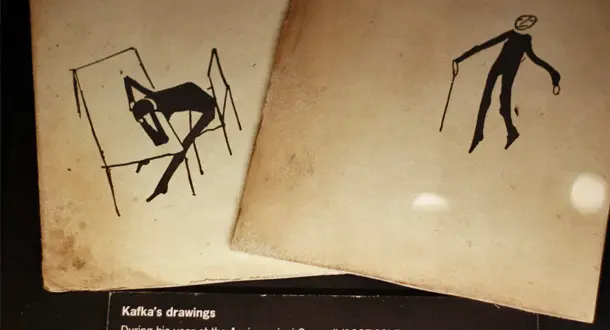
Franz Kafka Museum, Cihelná 2b; kafkamuseum.cz
In anticipation of the trip I started to read Kafka's The Trial, but was forced to abandon it halfway through because of the title's prescience (it was a trial to read). This, despite my fond memories of The Metamorphosis. Ah well. If you want to learn more about Kafka, Cath Murphy did a great job at that, and I won't try to replicate it. Check out her blagger's guide here.
Anyway, so I didn't finish The Trial. Which is fine. Nothing could have prepared me for the oddly disturbing Kafka Museum.
It’s two levels, and in the first section there are deep pools of shadow cleaved by harsh splashes of jaundiced light. Sad jewelry box music plays on a loop, occasionally interrupted by the cawing of crows. Display cases are suspended from chains and placards talk of Kafka's tortured genius and his fraught relationship with his father.
Then you get down to the second level, designed to resemble a giant array of filing cabinets (or the cabinets of a morgue), each one emblazoned with the name a Kafka characters or a person from Kafka's personal life. There are random telephones built into the wall and when you pick one up someone starts yelling at you in German, because, sure.
My friend Jacqui called it an existential museum with Kafka stuff in it. That’s a pretty accurate assessment. The Kafka stuff sure is interesting, though. Think a first edition of The Metamorphosis. Letters to his father. Drawings he did. It's definitely worth a visit, even if the whole thing feels a little overwrought, and only takes 15 minutes to get through.
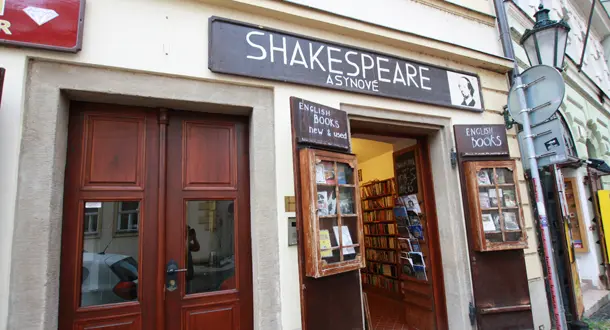
Shakespeare & Sons, U Lužického semináře 10; www.shakes.cz/
This bookstore is right around the corner from the Kafka Museum, so definitely worth a visit afterward. Right at the front it's got Prague-specific titles, so lots of Kafka, and books like The Prague Cemetery by Umberto Eco.
It's mostly English-language work, though, with a mix of other languages in there, too. I did find a Czech edition of a book by one of the authors I publish. Also, the A Song of Ice and Fire books in Czech! Which apparently is big there because I saw at least three people carrying or reading Czech editions of the series.
There's something to be said for a bookstore with a stone floor, which it has on the lower level. And the sitting area is fantastic—an alcove in the back with some comfy couches and a window overlooking a canal.
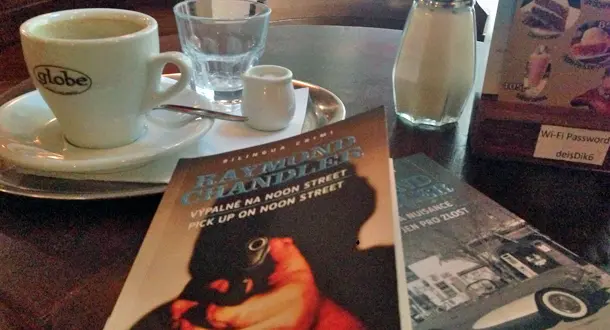
The Globe Bookstore & Café, Pštrossova 6; www.globebookstore.cz
The Globe just about saved me. I caught a cold halfway through the trip. We checked out of our apartment at 11 a.m., and had a 10 p.m. train to Poland. So in between, there wasn't much more to do than wander around. Not fun when your sinuses feel full of wet newspaper. After trying to sleep in a park—where it was too loud and the ground was too damp—I settled on The Globe.
It's a small place, but sort of perfect for a traveler. There's a nice, eclectic selection and plenty of English language books. And it's a cafe, so I could drink eight coffees in a row, which helped. Plus, it had the strongest WiFi of any place I had visited in Prague, so I could download the first episode of Breaking Bad's final season on my phone (!!!).
I scored some very cool Raymond Chandler books—two shorts stories of his, "Pick Up on Noon Street" and "Pearls are a Nuisance"—in an English/Czech edition. So one page would be English while the facing page would be Czech.
I would like to formally apologize to whoever works at The Globe who might be reading this, considering I was diseasin' up the joint, but still, it was an incredible respite from an otherwise miserable day.
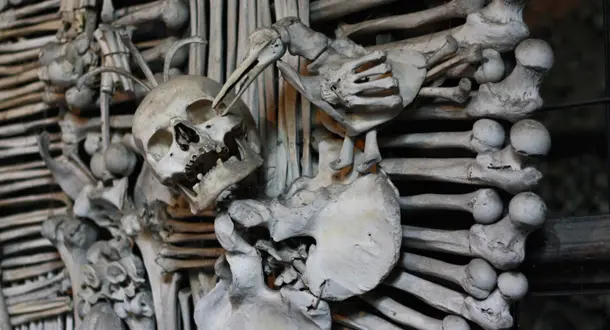
The Sedlec Ossuary, Kutná Hora; www.ossuary.eu/
The Sedlec Ossuary is a small Roman Catholic chapel beneath the Cemetery Church of All Saints. It's in Sedlec, a suburb of Kutná Hora, about an hour by train outside of Prague. It was a major plot device in the John Connolly novel The Black Angel, which I have not read, but I might, because it sounds cool.
A little history: In 1278 the abbot of the monastery went on vacation and brought back some soil from Golgotha (where Jesus was crucified) and sprinkled it over the abbey cemetery. Because of this, it became a very fashionable burial site. Between its popularity, the plague in the 14th century, and the Hussite Wars in the early 15th century, there were a lot of bodies to bury, so the cemetery kept expanding. Around 1400, a Gothic church was built at the center of the cemetery, and thus began its history as an ossuary—a final resting place for skeletal remains.
There are ossuaries throughout the world, and as ossuaries go, it's pretty cool. It's not as overwhelming as the Catacombes de Paris, which is more than a mile long. The Sedlec Ossuary really only takes 15 minutes to see the whole thing, but it's still an incredible sight. Though some might call it morbid, I would argue that the time and care that went into arranging these remains turns it into a celebration of life.
Other tips for visiting Prague:
- This is a great town if you're on a budget. One crown is about 5 cents USD, so you can get a nice meal and have a couple of beers for less than $10. The trick is to start in Staroměstské náměstí, the Old Town Square (their equivalent of Times Square) and move outward. That's the center of the tourist spiderweb, and the further you get from it, the better the deals, food, atmosphere, etc.
- If you're looking to splurge, check out La Degustation Bohême Bourgeoise. It's Michelin-starred, and while it's not cheap, it's much cheaper than a Michelin-starred restaurant in Manhattan or London. The food is bonkers and the wait staff isn't rude or condescending—which is what I expect in a joint where they bring you a new set of silverware for each course.
- The strip clubs are also brothels. The more you know.
- If you have a head cold, prepare to not be able to find cold medication anywhere. When you do, it won't be much more than a Vitamin C pill.
- You don't need to learn Czech to get around—English is spoken pretty much everywhere. Though, as with all countries, there's only six things you really need to know: Thank you (děkuji), I'm sorry (promiňte), please (prosím), bathroom (toaleta), cheers (na zdraví), and beer (pivo).
- Make sure you have a good map. This is a confusing city to get around on foot. I can't say much about the public transit—supposedly it's very good, but we never took it, because we walked everywhere. When every meal consists of pork and potatoes and two beers, you kind of have to.
- No, I did not drink absinthe. First, I've had absinthe and I really don't like it. Second, science tells us absinthe doesn't make you trip, and maybe never did—140 proof alcohol is enough to make you believe anything.
- This kind of advice should go without saying, but if you're wandering around looking for a place to drink, and you hear a Balkan folk band playing Hava Nagila, follow the music. Even if it's into a run-down, unmarked building... always follow the music.
Got questions about Prague? Ask 'em! Did I miss something? Tell us about it—share your Prague story in the comments.
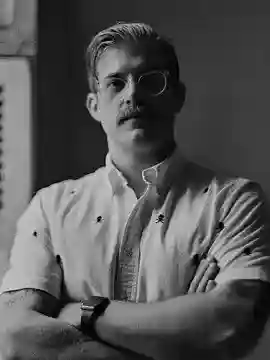
About the author
Rob Hart is the class director at LitReactor. His latest novel, The Paradox Hotel, will be released on Feb. 22 by Ballantine. He also wrote The Warehouse, which sold in more than 20 languages and was optioned for film by Ron Howard. Other titles include the Ash McKenna crime series, the short story collection Take-Out, and Scott Free with James Patterson. Find more at www.robwhart.com.







